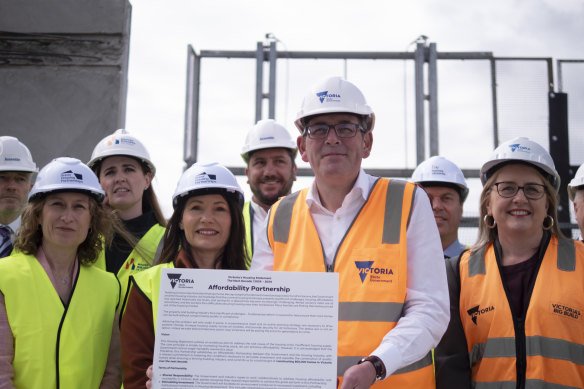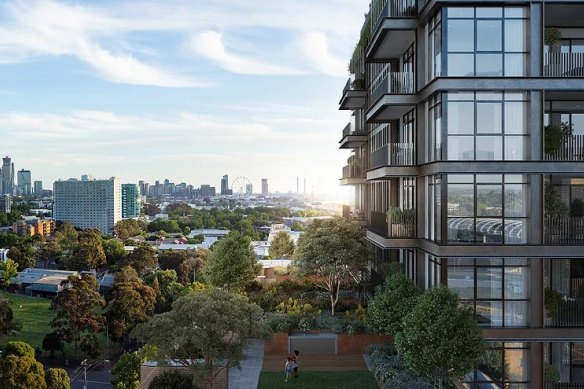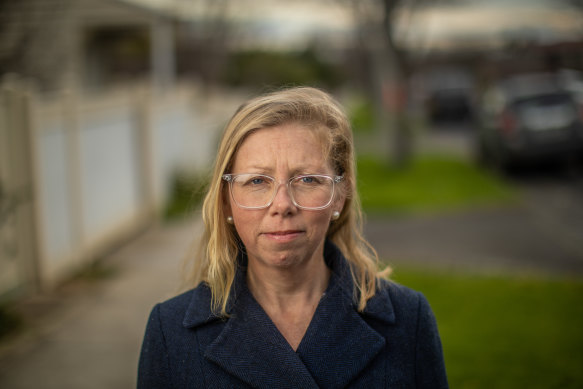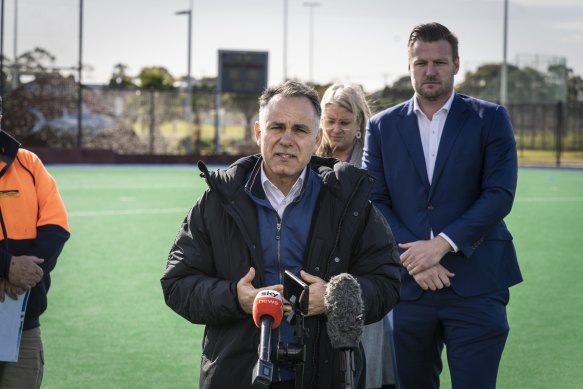Save articles for later
Add articles to your saved list and come back to them any time.
Victoria’s ambitious goal of building 80,000 new homes a year may not succeed without financial incentives, with the property industry warning reduced taxes and state-backing for projects are necessary to make sure homes actually get built.
The industry argues freeing up the planning system will not be enough to offset rising construction costs, difficult economic conditions and labour shortages that are holding back projects. Property developers are already sitting on approvals for tens of thousands of new dwellings they can start building any time – but haven’t.
The private sector may need more support to build new housing projects.Credit: Getty
When announcing Victoria’s housing statement on Wednesday, Premier Daniel Andrews said the major reforms contained in the document would be a “first step” in a larger effort to tackle the housing crisis.
This included immediate planning reforms, such as faster approvals for larger projects or medium-density builds around transport hubs if developers agreed to allocate at least 10 per cent of the build to affordable housing.
Government land will also be unlocked, planning backlogs tackled with new staff and clearer rules introduced to allow 60,000 homes to be built across activity centres such as Camberwell Junction, Epping and Niddrie.
Property industry groups, who played a key role in the changes, have welcomed the planning overhauls and signed an “affordability statement” committing to work with the state on its goal of creating 800,000 homes over the next decade.
Daniel Andrews releases his landmark housing policy.Credit: Elke Meitzel
But they have warned that the government now needed to encourage spending and get developers adding more homes to the market.
Soaring construction costs have contributed to the collapse of multiple home builders in Victoria, while labour shortages are also putting pressure on the system.
The Urban Development Institute of Australia’s Victorian chief executive, Linda Allison, said addressing these costs, adding tax incentives and promoting foreign investment were the next steps to fix the housing supply problem.
“The Victorian taxation system is currently an obstacle to investment, and many projects need investors to get them out of the ground, not just owner-occupiers,” she said.
“We need to remove barriers to investment, like the foreign purchaser additional duty to deliver the homes Victorians need.”
Allison said there should also be support for home buyers to give builders the confidence to back new projects.
She said this could include revisiting stamp duty exemption rules for off-the-plan projects, first home buyers and people looking to downsize.
“All those thresholds run out at $750,000, so even if they could keep pace with, or be close to, current prices, that could also act as an incentive,” Allison said.
Tax incentives for off-the-plan projects are among the ideas being floated.
“The investors or the purchasers need to be there to get projects out of the ground.”
The Andrews government has justified its planning reforms by warning the state must move faster to green light projects.
They have pointed to Australian Bureau of Statistics data showing a fall in the number of annual dwellings approved in the state, dropping by more than 8000 between June 2021 and 2022.
But on Wednesday, The Age revealed analysis from the Municipal Association of Victoria that suggested there were nearly 120,000 houses, townhouses and units that have been approved and not yet under construction.
The Planning Institute of Australia’s Victorian president, Gabby McMillan.Credit: Scott McNaughton
President of the Planning Institute of Australia’s Victorian division, Gabby McMillan, said reforming the approval of projects was just one element that needed to be addressed.
“It is okay to have a strategic plan saying these are the controls, but you also need to look at how do you practically implement that,” she said.
“Things like even having a government-led development corporation, or someone that was actually responsible for delivering projects.”
The state opposition has identified four examples of residential developments, in North Melbourne and Geelong, that have sat on the planning minister’s desk for at least six months and said the government shouldered much of the blame for the housing shortage.
Victorian Opposition Leader John Pesutto advocates lower property taxes as one way to address the housing crisis.Credit: Eamon Gallagher
“Fixing Victoria’s housing crisis requires solutions to lower property taxes, work with local residents and communities and restore confidence in the residential construction sector,” Opposition Leader John Pesutto said.
Emeritus Professor of Public Policy at RMIT University, David Hayward, said Victoria deserved a “pat on the back” for the housing statement and that it showed the third-term government wasn’t out of ideas.
But he said it lacked detail about how targets would be met. Questions remain over whether interest rates and the broader economy would limit funding for projects.
“There’s not a lot of detail given as to how they’re going to crank up the private sector,” Hayward said.
“Enforcing a target is quite difficult if you don’t control the variables.”
Over the next year, the state government will revamp its 30-year Plan Melbourne strategy to include housing targets for local government areas and Victoria’s planning laws will be overhauled.
As part of this process, policymakers will consider recommendations from the Independent Broad-based Anti-corruption Commission to take statutory planning powers away from councillors and hand these controls to independent panels.
Planning Minister Sonya Kilkenny said the revamped document would be a new plan for the entire state.
“That means consultations with all Victorians from every corner of the state.”
Responding to the state’s moves to take over more planning powers, Municipal Association of Victoria deputy president Joseph Haweil said projects should not become less transparent.
“Councils want to ensure communities are not completely locked out of the planning process with no third-party appeal rights in respect of these applications,” he said.
Get the day’s breaking news, entertainment ideas and a long read to enjoy. Sign up to receive our Evening Edition newsletter here.
Most Viewed in Politics
From our partners
Source: Read Full Article




